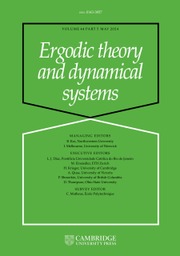No CrossRef data available.
Article contents
Borel complexity of sets of points with prescribed Birkhoff averages in Polish dynamical systems with a specification property
Published online by Cambridge University Press: 02 April 2025
Abstract
We study the descriptive complexity of sets of points defined by restricting the statistical behaviour of their orbits in dynamical systems on Polish spaces. Particular examples of such sets are the sets of generic points of invariant Borel probability measures, but we also consider much more general sets (for example,  $\alpha $-Birkhoff regular sets and the irregular set appearing in the multifractal analysis of ergodic averages of a continuous real-valued function). We show that many of these sets are Borel in general, and all these are Borel when we assume that our space is compact. We provide examples of these sets being non-Borel, properly placed at the first level of the projective hierarchy (they are complete analytic or co-analytic). This proves that the compactness assumption is, in some cases, necessary to obtain Borelness. When these sets are Borel, we measure their descriptive complexity using the Borel hierarchy. We show that the sets of interest are located at most at the third level of the hierarchy. We also use a modified version of the specification property to show that these sets are properly located at the third level of the hierarchy for many dynamical systems. To demonstrate that the specification property is a sufficient, but not necessary, condition for maximal descriptive complexity of a set of generic points, we provide an example of a compact minimal system with an invariant measure whose set of generic points is
$\alpha $-Birkhoff regular sets and the irregular set appearing in the multifractal analysis of ergodic averages of a continuous real-valued function). We show that many of these sets are Borel in general, and all these are Borel when we assume that our space is compact. We provide examples of these sets being non-Borel, properly placed at the first level of the projective hierarchy (they are complete analytic or co-analytic). This proves that the compactness assumption is, in some cases, necessary to obtain Borelness. When these sets are Borel, we measure their descriptive complexity using the Borel hierarchy. We show that the sets of interest are located at most at the third level of the hierarchy. We also use a modified version of the specification property to show that these sets are properly located at the third level of the hierarchy for many dynamical systems. To demonstrate that the specification property is a sufficient, but not necessary, condition for maximal descriptive complexity of a set of generic points, we provide an example of a compact minimal system with an invariant measure whose set of generic points is  $\boldsymbol {\Pi }^0_3$-complete.
$\boldsymbol {\Pi }^0_3$-complete.
MSC classification
- Type
- Original Article
- Information
- Copyright
- © The Author(s), 2025. Published by Cambridge University Press



